Wood is a porous and fibrous structural tissue found in the stems and roots of trees and other woody plants. It is an organic material – a natural composite of cellulose fibers that are strong in tension and embedded in a matrix of lignin that resists compression.
In this article, Internal structure of Wood in some plants will be discussed briefly.
Internal Structure of Wood
Internal structure of Wood varies from plant to plant. Wood anatmoy of three plants are described below. These three plants are:
- Tectona grandis
- Mangifera indica
- Bombax ceiba
Best safe and secure cloud storage with password protection
Get Envato Elements, Prime Video, Hotstar and Netflix For Free
Best Money Earning Website 100$ Day
#1 Top ranking article submission website
Tectona grandis
Tectona grandis is from the family Verbanaceae. It is a wood of Segoon, a high-quality, timber-yielding plant, is ring-porous. It emits a leather-like odour, and its all the medullary rays are of one type.
Transverse Section of Stem:
In the T.S. of stem, following observations are noticed:
- The stem is circular is outline and remains surrounded by a few-layered zone of cork followed by cork cambium and secondary cortex. The endodermis and pericycle are not clearly demarcated.
- During secondary growth, vascular cambium cuts secondary phloem towards outer side and secondary xylem towards inner side.
- Wood or secondary xylem is formed by tracheids, vessels, xylem fibers and xylem parenchyma.
- Due to the presence of vessels, the wood is said to be porous. Vessels present in the early-wood are very large and form conspicuous rings in this wood while those present in the late wood are small or only moderately large. The wood with these characteristics is called ring porous.
- Distinct annual rings or growth rings are seen in the wood. A gradual transition from early-wood to late-wood is also visible.
- Around the vessels is present a clear and thin sheath of wood parenchyma cells.
- Medullary rays are 1-3 cells wide and are usually not very prominent.
- Patches of primary xylem are present near the centrally located parenchymatous pith.
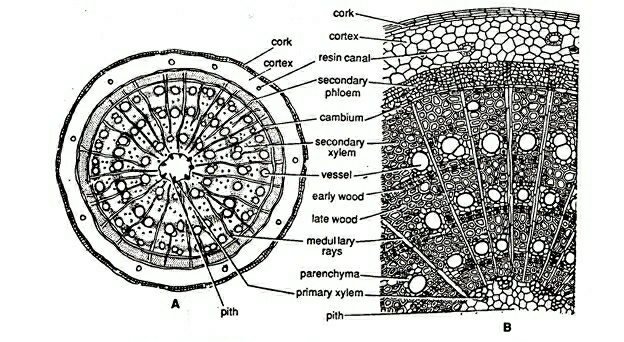
R.L.S. Wood
In the Radial Longitudinal Section of wood,
- Vessels are quite broad and long and their end walls are simple and perforated.
- Parenchyma cells remain associated with vessels.
- Usually tyloses and sometimes yellowish deposits are clearly seen in the vessels.
- Medullary rays are broad, scanty and hetero- cellular, and are seen at right angle to the long axis of xylem elements in R.L.S.
- Xylem fibres are septate and inter-vascular pittings are fine and alternate.
T.L.S. Wood
In the Tangential Longitudinal Section of wood,
- Tracheids, vessels, fibers and parenchyma are cut longitudinally in T.L.S.
- Vessels are broad, connected end to end with perforated end walls, and the
perforations are simple. - Tyloses and sometimes yellowish deposits are seen in the vessels.
- Medullary rays are cut across in T.L.S. They are 1-3 cells wide and several cells long.
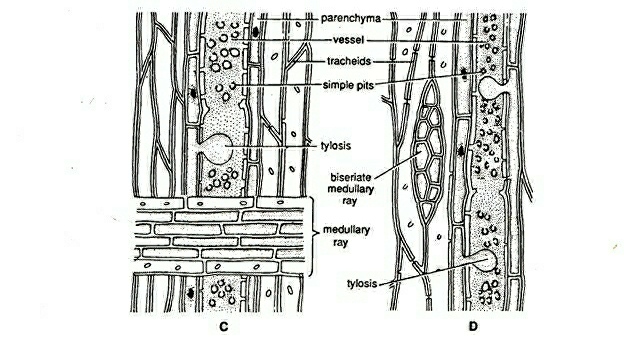
Mangifera indica
Mangifera indica is from the family Anacardiaceae. Wood is moderately hard, light colored, diffuse porous; contains tannin cells and resin canal; clearly demarcated sapwood and heartwood.
Transverse Section of Stem
In the T.S. of stem, following observations are noticed:
- Cork, cork cambium and secondary cortex form the periderm. One side of the cork cells consists of sclerotic walls.
- Tannin cells, crystals, stone cells and resin canals are present in the cortex.
- The peripheral side of the each resin canal remains enclosed by an arc-shaped strand of fibers which represent pericycle.
- Tannin sacs and fibers containing crystals are present in the region of secondary phloem.
- A continuous cylinder of secondary xylem is traversed by medullary rays.
- Medullary rays are narrow, closely spaced, and uniseriate or sometimes biseriate.
- Vessels are angular, large, thin-walled, numerous and uniformly distributed throughout the wood. They make the wood diffuse porous.
- Xylem parenchyma is large and paratracheal, i.e. found round the vessels.
- Parenchymatous pith contains secretory ducts covered with epithelial cells.
- Growth rings are clearly observed, and usually they are limited by xylem parenchyma.
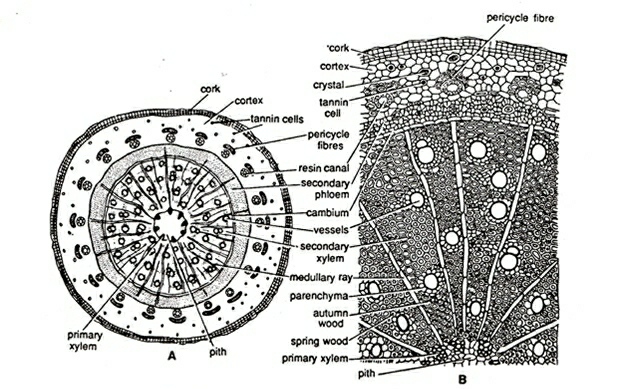
R.L.S. Wood
In the R.L.S. of wood,
- Large and broad vessels with simple or sometimes scalariform perforation plates are present. Living cells of parenchyma remain always associated with vessels.
- Medullary rays consist of two types of cells, and are seen at right angle to the long axis of xylem elements in R.L.S.
- Fibers contain simple pits and septa.
- Tyloses are inconspicuous and scanty.
T.L.S. Wood
In the T.L.S. of wood,
- Large and distinctly broad vessels with simple or scalariform perforation plates are also seen. Parenchyma cells also remain associated with the vessels.
- The medullary rays are cut transversely. They are mostly uniseriate and only rarely biseriate.
- Fibers contain simple pits and septa.
- Tyloses are inconspicuous and scanty.

Bombax ceiba
Bombax ceiba is commonly known as Cotton tree. It is from the family Malvaceae. A tall decidous tree with a spreading crown. It is an excellent choice as a pioneer species for restoring native woodland or for establishing woodland gardens.
Transverse section of wood
In the T.S. of wood, following observations are noticed:
- Vessel and tracheid are many.
- Scattered arrangement of vessels.
- More Xylem parenchyma.
- Elongated ray parenchyma.
- Less number of xylem fiber.
- Thin walled xylem.
Longitudinal Section of Wood
In the L.S. of wood, following observations are seen:
- Squared shaped ray parenchyma.
- Tube like vessel.
- Simple pits present on vessel wall.
- More xylem parenchyma.
- Tracheids are present.
Tangential section of Wood
In the Tangential section, following observations are seen:
- Lens shaped ray parenchyma.
- Multi-seriate ray parenchyma.
- More ray parenchyma.
- Long and thin walled xylem fiber.
- Elongated xylem parenchyma.
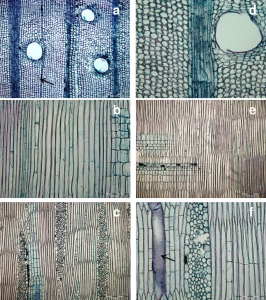
Comments on wood
From the Transverse, Longitudinal and Tangential section of Bombax ceiba wood, following comments can be said:
- Diffuse porous wood.
- Xylem parenchyma and ray parenchyma are many.
- Fibers are few in number.
- Fiber wall is thin.
So, the wood is soft and low in quality.
Reference:
1. Class Lecture of Parveen Rashid, PhD
Professor, Department of Botany, University of Dhaka.
 Plantlet The Blogging Platform of Department of Botany, University of Dhaka
Plantlet The Blogging Platform of Department of Botany, University of Dhaka
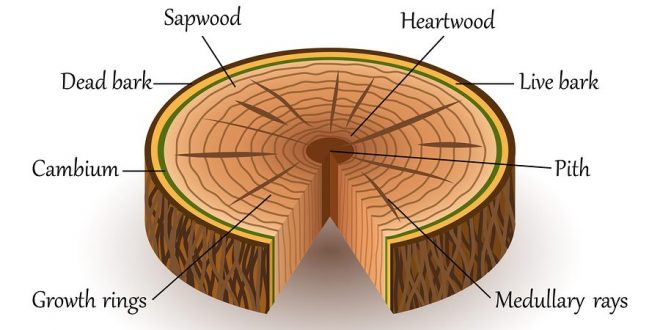

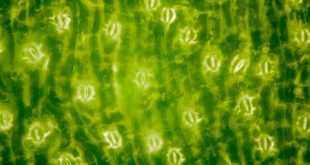
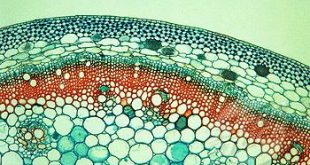
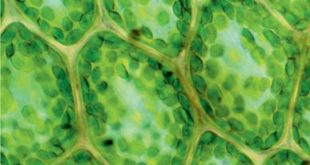
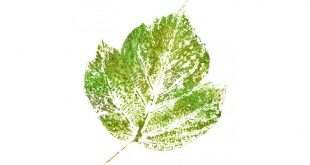
Very detailed article. I wish there was a description for Magnolia though..